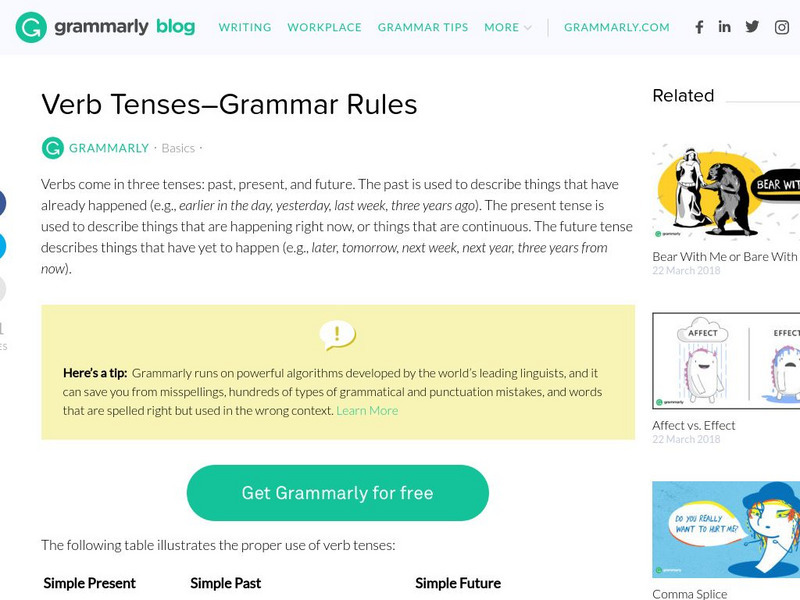Grammarly
Grammarly Blog: Verb Tenses: Grammar Rules
This page explains the three major verb tenses: past, present, and future with examples. It also offers links to information about each of these as well as the perfect, continuous, and perfect continuous of each.
Grammarly
Grammarly Blog: All About Transition Words
Types of transition words and how they can be used to make writing more fluid.
Grammarly
Grammarly Handbook: Planning
Tips for planning an essay. Links to additional information on the topics Assess the Situation, Think about Writing Ideas, How to Write a Thesis Statement, and How to Write an Outline are provided.
Grammarly
Grammarly Handbook: Writing a Draft
This page focuses on writing a first draft including getting all the information down in an organized manner without worrying about the grammar and mechanics. It discusses the advantages of using word processing programs which make it...
Grammarly
Grammarly Handbook: Writing Concisely
This page compares wordy writing to a art gallery cluttered with a mixture of great works and poor attempts making it hard to see the great works. Remove the clutter, write concisely so the reader gets the point of the paper. It offers...
Grammarly
Grammarly Handbook: What Are Adverbs?
This short article briefly explains the purpose of adverbs, how to identify them, and provides an example.
Grammarly
Grammarly Handbook: Parallelism With Gerunds and Infinitives
An explanation with examples of using parallel structure with gerunds and infinitives.
Grammarly
Grammarly Handbook: Parallelism: Lists After a Colon
An explanation of how to use parallel structure in lists.
Grammarly
Grammarly Handbook: Visuals: Graphs, Charts, and Diagrams
This article explains that graphs, charts, and diagrams are used to display information visually. The choice of what type of graph or chart to use depends on the information to be displayed. Software programs make these much easier to...
Grammarly
Grammarly Handbook: Unnecessary Words and Phrases
This page explains the need to revise writing to remove unnecessary words and phrases to produce clear, concise writing. Examples are provided.
Grammarly
Grammarly Handbook: Appropriate Vocabulary
This page focuses on the choice of vocabulary in a paper: Is it clear and appropriate for the audience? Does the vocabulary fit the subject matter? W.11-12.2d Lang/Fig/Voc
Grammarly
Grammarly Handbook: Sentence Structure
Tips on how to vary sentence structure to strengthen writing.
Grammarly
Grammarly Handbook: Wordiness
This page focuses on reducing wordiness in writing by using more concise language, and avoiding extra-long words and sentences.
Grammarly
Grammarly Handbook: Academic Writing: Specific Requirements
This page focuses on academic writing requriements and includes links to Argumentative (Persuasive) Writing, Essay Writing, and How to Write a Research Paper.
Grammarly
Grammarly Handbook: Organization and Development
A list of five focuses in the areas of organization and development. Links to each focus area are provided.
Grammarly
Grammarly Handbook: Research and Documentation
An explanation of the importance of research and documentation and links to specific information for each.
Grammarly
Grammarly Handbook: Shifts in Writing
Five areas to edit for shifts in writing: Consistent Point of View, Consistent Verb Tenses, Verbs Consistent in Mood and Voice, Shifts from Indirect to Direct Questions/Quotations, and Shifts from British to American English. Each area...
Grammarly
Grammarly Handbook: Organization
A list of the six parts of a thesis paper with links to more information on each.
Grammarly
Grammarly Handbook: Appearance
This page focuses on the appearance of the paper after the writing is complete. It offers links to a pre-printing checklist and a post-printing checklist.
Grammarly
Grammarly Handbook: Research
A list of the six steps of the research process with links to more information on each.
Grammarly
Grammarly Handbook:capitalization:call Letters of Radio and Television Stations
This page explains that call letters for radio and television stations are always in all capital letters and provides examples.
Grammarly
Grammarly Handbook: Italics and Underlining: Foreign Words
An explanation and examples using italics/underlining when writing foreign words in a sentence.
Grammarly
Grammarly Handbook: Negatives
An explanation of a negative sentence and a list of words that show a negative idea.




